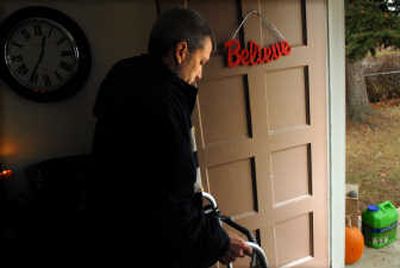‘Defiantly improved’

Barry Lehinger still counts each step he takes. After the vehicle in which he was riding rolled on a lonely stretch of Alaska highway in May 2004, the Spokane man was never expected to walk again. He left much of his memory and some of his personality on that road, but not his will. So he counts each step on his new road to recovery and marks it in a notebook. He has counted more than 900,000 steps since waking from a coma 3 ½ years ago. When he awoke, Lehinger found his girlfriend, Wendy Darnold, at his side. And that is where she is now after giving up her job to provide full-time care to the man she loves. With the little money she has been able to put aside from disability payments, her income as Lehinger’s caregiver and a part-time job at Deaconess Medical Center, she was able to move them both into a modest home in north Spokane last spring. “What’s kept me in this is anything is possible,” Darnold said. “There has been so much progress.” Lehinger’s physician, Dr. Karen Stanek of Northwest Medical Rehabilitation, said Lehinger has “defiantly improved,” though he continues to have a mood disorder that makes him argumentative at times. “He does pretty well with writing but doesn’t seem interested in staying on task,” Stanek said. “As far as being able to carry on a pleasant conversation, he’s not there yet.” Now there is new hope for Lehinger, 38. He is on a list of applicants to participate in a Salt Lake City feasibility study to determine whether hyperbaric oxygen can affect patients with traumatic brain injuries. It is believed that with more oxygen, damaged neurons may function better, according to Dr. Lindell Weaver, a specialist in critical care and hyperbaric medicine at LDS Hospital and the Intermountain Medical Center. “Another notion is that hyperbaric oxygen improves stem cell growth,” Weaver said. There is evidence that stem cells are released from hyperbaric oxygen, but whether these stem cells can produce brain cells is not known. If approved, Lehinger will undergo 60 days of hyperbaric treatment at the low cost of $25 per session. But he and Darnold must also come up with the cash to pay living expenses during the treatment in Utah. Last spring, Lehinger received a visit from his 19-year-old daughter, Kayla. He had never met the child of a Seattle woman with whom Lehinger had a teenage romance. “The first I ever heard of her, and her being an adult, was kind of strange,” Lehinger said. “It’s unfortunate we couldn’t stay together, but my time machine is broken. I can’t go back and do it all over.” During the visit, Darnold noticed a bond between father and daughter, and a remarkable capacity for communication. “He is amazing and is a miracle,” Darnold said. “He is determined never to give up.”